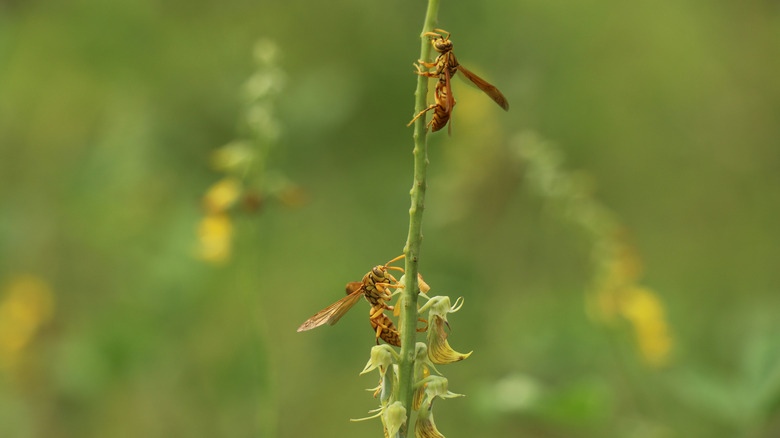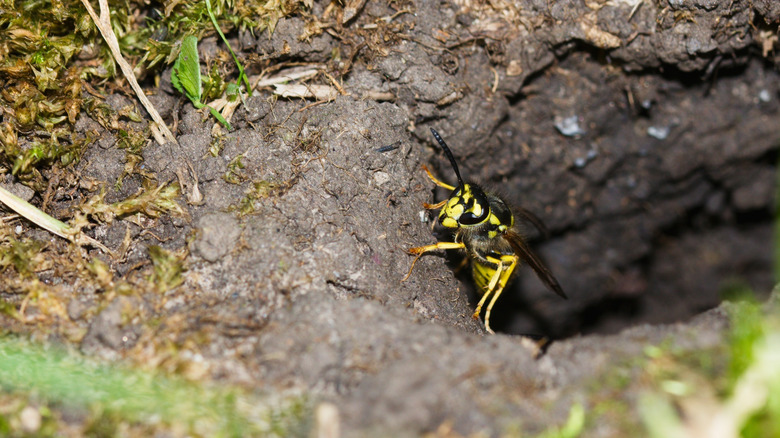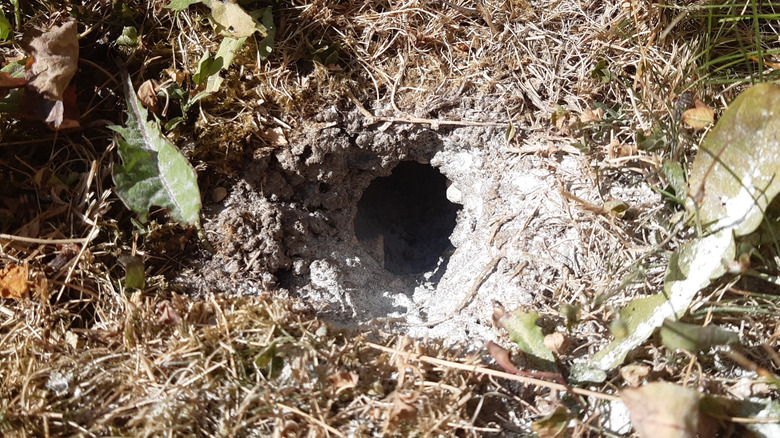How To Spot A Yellowjacket Ground Nest (And How To Get Rid Of It)
If you notice a bunch of insects with black and yellow stripes buzzing around your backyard, they may not be the bees you think they are. Instead, they may be yellowjackets. These insects are a type of wasp that can be found throughout the United States during the summer months, especially in the southeastern region. They may look similar to bees in size and color, but they have very different habits.
Yellowjackets are carnivorous, eating other insects, meat, fruits, and more. They can also be more likely to sting than bees, which makes them a far worse insect to have flying around your garden. They can even sting repeatedly without hurting themselves, unlike bees. One reason they may sting a person is if their nest is approached or disturbed. Since their nests are often tucked away underground, this could be a problem every time you attempt to use your yard. So, it is important to locate the nest, get rid of it, and then learn some ways to get rid of yellowjackets so they don't build another home in your yard.
If you suspect there are yellowjackets in your garden, then the first thing to do is attempt to locate the nest. They typically build nests underground in abandoned burrows, but they can also build in piles of wood, vegetation, or other spots that are protected from the elements. This can make nests hard to find, especially in large yards. For the best searching conditions, carefully and methodically walk your yard in late morning or late afternoon when the wasps will be active and easy to see, and look for concentrations of the insects. Start near holes in your yard, and look for clusters or lines of the stinging insects going toward that opening.
Identifying a yellowjacket ground nest
If you are having trouble locating the nest, you might be able to bait a yellowjacket into leading you there. All you need to do is place a piece of meat in an area where you usually see the insects and wait. Eventually, a yellowjacket may come and pick up a piece to take back to the nest. Once it does, you can carefully follow it until it returns to the nest. While they are attracted to a few food items, meat is ideal for this task because it is used to feed the larvae, which are in the nest. Once you find one nest, carefully scan the rest of your yard because there may be multiple. In the event you find multiple nests in your yard, you will probably want to know why yellowjackets are so attracted to your yard so that you can better prevent them from returning.
While searching, it is important to take efforts to prevent yourself from being stung. Yellowjackets are territorial and become agitated when their nests are disturbed, so be extremely mindful of where you step while you search. Also, avoid killing any of the insects during the process. Not only will you be removing an insect that could lead you to the nest, but you also might alert nearby wasps that you are a threat and be chased down by the stinging insects. Move slowly and wear protective gloves, glasses, and clothing while you search.
How to remove a yellowjacket ground nest from your yard
Once you have found a ground nest and confirmed that it is being used by yellowjackets, you can decide how to proceed with removing it. Anyone with known or suspected allergies to yellowjacket stings should not make any attempt to approach the nest. Note the location and call a professional to take care of it. Calling a professional is also a general recommendation by many wildlife and pest control companies because of the yellowjackets' ability to sting repeatedly and tendency to swarm and follow threats.
If you do decide to get rid of the nest yourself, then you can do so by treating the nest with a registered insecticide spray and dust. Ideally, you should approach the nest at night when it is below 55 degrees Fahrenheit and you are wearing protective gear. Yellowjackets are less active at night and in the cold, and they cannot see very well in the dark. This means that you are less likely to be stung during your eradication attempt.
Treat the ground nest and the surrounding area according to the insecticide's instructions. You should be able to check the nest the next day to see if there is any activity around the nest or if you successfully got rid of it. If any yellowjackets were outside of the nest, which is less likely at night, you can learn how to make a four-step DIY wasp trap to catch any stragglers.


